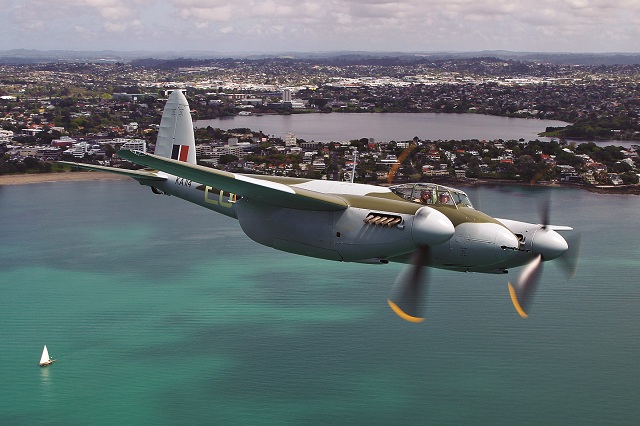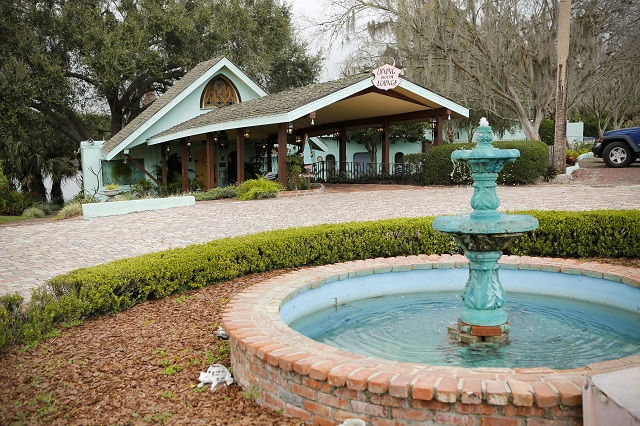Mosquito bomber heading for U.S.
Restoration took place in New Zealand
By Alton K. Marsh
The Fighter Factory in Virginia Beach, Virginia, will soon add a restored and flying de Havilland Mosquito bomber to its collection. It was built for Fighter Factory owner Jerry Yagen with parts made from new tooling by Glyn Powell of Mosquito Aircraft Restoration and by Avspecs Ltd., both located near Auckland, New Zealand.
Avspecs is owned by Warren Denholm and his wife, Shona, and was started in 1997. The rebuilt airplane first flew in September 2012. The nearly 400-mph airplane has a final approach speed of 120 mph. Pilot Dave Phillips wrote in Warbird Digest that it’s better to read about power-on stalls in the Mosquito than to practice them. “Not wanting to end up inverted in the landing configuration, we have not investigated this,” he said. Denholm—who went along on the first flight—said that the aircraft has reached 380 mph on later flights.
Denholm said the roll rate is good at 200 mph but slows and the ailerons stiffen after that. “It’s much better being in the cockpit looking at the instruments and discussing issues with the pilot right next to you than standing on the ground with a walkie-talkie nervously hoping that everything looks all right. The test flight was most successful, even though I didn’t take a breath for 57 minutes.” Based on research, the pair believed that the Mosquito “was going to be this terribly vicious airplane to handle and that it would swing violently on takeoff. None of that eventuated at all. It performed flawlessly,” Denholm said.
Denholm said its value is now three times what was spent to restore it. He noted that in England it costs about $3 million to restore a Spitfire, and the Mosquito could be considered comparable to a Spitfire restoration.
You can see the Mosquito fly at the Fighter Factory’s airshow, “Warbirds Over the Beach,” May 17 to 19 in Virginia Beach. It also will appear in Canada at the Hamilton Air Show near Toronto in mid-June. The airplane was built near that site in 1945.
Email [email protected].
Spec sheet
Mosquito FB.26
- (Built in Canada in 1945)
- Wingspan | 54 feet 2 inches
- Length | 39 feet 9 inches (tail down)
- Wing area | 454 square feet
- Engines | 2 Packard Merlin 1,620 hp each
- Propellers | Three blade 12 feet diameter
- Fuel capacity | 858 gallons (U.S.)
- Max speed | 378 mph at 13,200 feet
- Economy cruise | 250 mph
- Ceiling | 26,000 feet
- Construction | Canadian spruce spars, beech and birch plywood, balsa panel core material, walnut wing attachment points
- Max weight | 21,473 pounds
- Range | 1,120 miles, 960 miles at sea level
- Crew | Pilot and observer (navigator)
- Armament | 4 20mm cannons, (4) machine guns, (8) rockets, (2) 250- or 500-pound bombs internally, and (2) 250- or 500-pound bombs externally.
A panel takes shape
Panel precision via CAD-CAM technology
By Thomas A. Horne
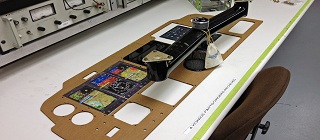 A preview of the panel cutout and how the
A preview of the panel cutout and how the
Aspen Evolution 2500 will fit into the picture.
One of the more satisfying aspects of an AOPA sweepstakes renovation project is seeing the new instrument panel come to life. This transformation begins in small, time-consuming stages, so in the first few weeks of avionics work there’s not a lot of progress apparent to the untrained eye. Sure, the original panel’s old gear has been removed, but now the wiring bundles are being painstakingly assembled, the new switches and relays are being connected and tested, and the actual panel template is in the process of being cut. Compared to the panel-cutting part, the grunt work can seem mundane.
Santa Fe Aero Services had to yank out yards and yards of 50-year-old wiring—because why create a state-of-the art panel and retain the original wires?—and all that takes time. It takes even more time to assemble the new bundles. While that’s going on, Santa Fe Aero digitally scanned the old panel and created a new, computer assisted design (CAD) model that’s accurate to within 1/10,000 of an inch. Think the new panel will fit the perimeter dimensions of the old one? You bet it will, right down to perfect matches of the original panel’s mounting screw holes, thanks to the CAD’s perfect measurements.Once that was done, avionics cutouts were added to the CAD model so that they and other panel components will fit exactly into them. Computer-assisted machining takes this information and turns on the shop’s computer numeric control machining router. The end result is an aluminum panel ready for installation.
At the same time, Santa Fe Aero sent out the control yokes for refurbishment, and the fuel sending units were overhauled. The old analog units simply weren’t up to the standards required by the Debonair’s new Electronics International MVP-50P engine and systems analyzer and, like the old wiring, it just made sense to upgrade the 50-year-old senders.
Stay tuned for more updates on this exciting project—in AOPA Pilot, online at our brand-new Debonair Sweepstakes blog, and, in the near future, on video reports on AOPA Live This Week weekly webcast.
Email [email protected].
Boeing 737 lands in Antarctica
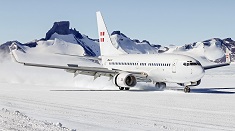 A chartered PrivatAir 737 touched down at Troll Research Station 146 miles from the Antarctic coast in November 2012. The flight was arranged by the Norwegian Polar Institute through Aircontact, a Norwegian air charter broker. PrivatAir is headquartered in Geneva, Switzerland, with bases in Germany and the Congo. The flight originated from South Africa.
A chartered PrivatAir 737 touched down at Troll Research Station 146 miles from the Antarctic coast in November 2012. The flight was arranged by the Norwegian Polar Institute through Aircontact, a Norwegian air charter broker. PrivatAir is headquartered in Geneva, Switzerland, with bases in Germany and the Congo. The flight originated from South Africa.
The research center is in the eastern part of Princess Martha Coast in Queen Maud Land, Antarctica.
The research station does environmental and climate monitoring plus mapping. The flight took place during that continent’s summer, with temperatures hovering between 5 and 24 degrees F, depending on the time of day—a heat wave in that part of the world.
The aircraft was equipped with a SatCom system to receive weather updates during the six-hour flight to the 9,800-foot ice runway. The aircraft’s ability to take off and land on ice was analyzed (including engine performance), and two members of the crew received Arctic survival training.— Alton K. Marsh
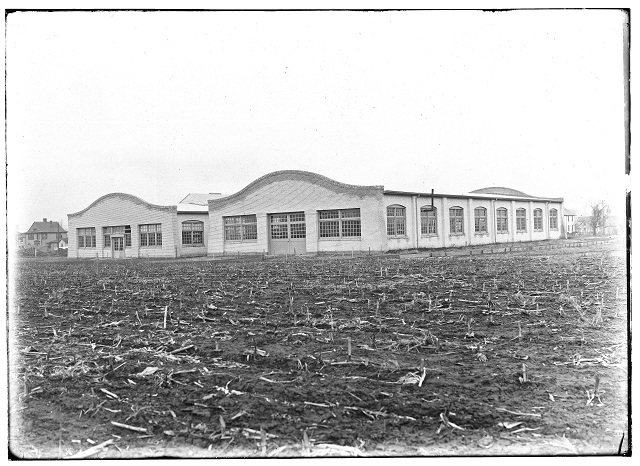 This historic photo of the Wright factory buildings is from the Library of Congress.
This historic photo of the Wright factory buildings is from the Library of Congress.
Wright factory to be preserved
Continuing a legacy
By Alton K. Marsh
Efforts are in progress at Dayton, Ohio, to save and display the first aircraft factory in the United States—which, since 1919, has been used to build car parts. General Motors first bought it in 1919 and built parts made by AC Delco (Dayton Electric Company) and Delphi until 2008.
Home Avenue Redevelop-ment LLC has recently taken title to the site that includes the historic Wright Company factory buildings. The acquisition puts the company in position to redevelop the Delphi plant for commercial use while preserving the Wright Company factory site for public use as an element of the Dayton Aviation Heritage National Historical Park. In 2009, President Barack Obama signed a law that expanded the national park’s boundaries to include the factory site and Hawthorn Hill, the Wright family mansion in Oakwood.
Today the factories sit surrounded by larger buildings built by General Motors and Delphi. They are the oldest aircraft factory buildings still standing anywhere in the world—thanks to the car industry.
A 1911 photo shows what the factory looked like from 1910 until 1916, when aircraft production stopped, but parts were still made until 1919 for assembly at the Wright plant in Moraine, Ohio. Wilbur Wright died in 1912, and Orville sold his holdings in the company in 1915. General Motors bought it in 1919.
Hull and Associates formed Home Avenue Redevelopment to redevelop the site with the help of a $3 million Clean Ohio Fund matching grant.
“The birthplace of the aircraft industry has taken a major step toward preserving an historic treasure,” said Brad White, a principal of Hull and Associates.
Wilbur and Orville Wright formed the Wright Company in New York in 1909 and built the first factory building in 1910. Aircraft production ceased in 1916. General Motors acquired the buildings in 1919 and soon converted them to auto manufacturing.
It will be a couple of years before the Wright factory is returned to its early appearance and is opened to visitors, said Tony Sculimbrene, executive director of the National Aviation Heritage Alliance in Dayton. The National Aviation Heritage Alliance is a not-for-profit corporation designated by Congress as the management entity of the heritage area. Its vision is to make the Dayton region the recognized global center of aviation heritage and premier destination for aviation heritage tourism, sustaining the legacy of the Wright brothers.
Email [email protected].
Eclectic excellence
Chalet Suzanne’s soup has flown in space
By Alton K. Marsh
Chalet Suzanne Restaurant and Country Inn at Lake Wales, Florida, situated on a 2,300-foot grass strip (X25), has stood since 1931 as a monument to reinvention and survivability. Dee and Eric Hinshaw are the third generation of aviators to oversee the 26-room hotel and restaurant built by Eric’s grandmother, Bertha Hinshaw. Her friends included J. L. Kraft of the Kraft Cheese Company and Duncan Hines. At first she used her fine china but resorted to table settings purchased from estate sales or donated when the restaurant expanded, a tradition that continues. “This place is the epitome of eclecticism,” says Hinshaw, meaning the plates, glasses, and dishes don’t match and wall decorations are a disparate collection from hundreds of homes.
The restaurant has won the Florida Trend Golden Spoon Award 30 years in a row and is in the Hall of Fame. With every meal guests enjoy the restaurant’s signature Romaine soup—also known as Moon Soup and canned right at the restaurant—that was selected by NASA for Apollo 15 and 16, and chosen by Russian cosmonauts for the joint Apollo-Soyuz meeting in space. Chalet Suzanne is housed in former farm buildings. You enter where the farmhands had rooms and walk through the former horse stable to the maître d’. You pass the former chicken coop on your right where the Golden Spoon Awards hang. The buildings were built between 1910 and 1920.
The restaurant was never French, yet many have that impression. It is classified as a Continental restaurant with international cuisine. Equally inaccurate is the impression that the restaurant is expensive, but the lunch menu starts at $9 for a filling salad. I had the $12 Black Angus burger that comes with caramelized onions and crumbled bleu cheese; French fries included. The taste is one no home-grill cook will ever achieve. The most expensive items on the lunch menu are the grilled twin-lamb noisettes and Maine lobster Newberg—Chalet Suzanne’s classic interpretation.
The Hinshaws host a Sun ’n Fun barbeque at the grass strip each year. Eric is a former United Airlines captain who keeps a Piper Twin Comanche, a Blanik glider, a Pitts biplane, and a Cessna 140 beside the hotel.
Email [email protected].
If you go
Chalet Suzanne Air Strip (X25)
800-433-6011
www.chaletsuzanne.com
Rental cars: www.aopa.org/cars
866-315-9155
People
100 years and still flying
Thomas Guy Reynolds Jr. first flew on his sixteenth birthday. And he flew again on his birthday in November 2012. “I try to fly 100 hours a year,” he says. Which happens to be his age. To celebrate his first century Reynolds circled Eastern West Virginia Regional Airport, in Martinsburg, West Virginia, in his Czech-built Evektor SportStar LSA. Eastern Regional was the first airport that Reynolds ever flew from, in a Ford Trimotor in 1929. He got his license in 1943. In 1952 he got his commercial certificate—but didn’t fly for the next 52 years. He renewed his private certificate in 2004. He’s now logged 1,000 hours and plans to go up when he’s 101. “That’s pretty good for a young boy,” he says.— Phil Scott
2,000 feet above Dallas
Aerial tours keep this entrepreneur flying
By Jill W. Tallman
David Snell navigates effortlessly through the somewhat congested, sometimes complicated airspace above Dallas in a Cessna 172. On this bright morning, he checks in with approach control at Dallas-Love Field with the ease of someone who’s flown this route many times.
Snell operates Starlight Flight, an aerial tour company he conceived in 1991 while still an undergraduate student at Louisiana Tech. Back then, he faced the aspiring airline pilot’s conundrum: He needed to log time, and since he didn’t have a flight instructor certificate (he did eventually get one), his options were limited to nonstop aerial tours, aerial photography, and survey flying.
Now, 2,000 feet above Dallas, Snell points out the expanse of Lake Lewisville before pointing the Skyhawk toward a large white expanse to the west. The Texas Motor Speedway is hosting a NASCAR race, and Snell and his passenger will be able to circle the speedway before a temporary flight restriction takes effect. After some genial consultation with Fort Worth Approach, Snell receives the go-ahead to climb to 2,500 feet, well above banner-tow aircraft and helicopters hustling passengers to the speedway’s helipad.
Snell doesn’t own the Skyhawk—has never owned an aircraft, in fact. He rents it at $150 per hour. He charges $190 for two passengers and a 30-minute tour of the Dallas/Fort Worth area, or $245 for an hour tour. As he doesn’t own the airplane, he doesn’t pay for its operating expenses or a hangar. He doesn’t have an office in which to meet customers. Instead, he greets them in the well-appointed lobby of the Million Air FBO at Addison Airport. (He purchases fuel from Million Air, so everybody’s OK with that arrangement.) His only other costs are commercial insurance and a part-time receptionist who schedules flights.
“We have done more aerial tours than any other local operator,” Snell says. “We’re so inexpensive compared to my competitive market, which are the helicopters.” Starlight Flight has a letter of authorization from the FAA, and its own call sign.
Snell didn’t become an airline pilot, but he wanted to keep flying, and says the tour business he started in college pays for that. He owns two other businesses—crawfish catering and custom wood floors—and Starlight Flight’s mostly weekend business enables him to run those without interruption. During peak season, which begins at Christmas, Snell will pay local flight instructors to take up some of the customers. “A percentage of people who go on the tour know that their spouse had an interest in flying,” he says. “We’re able to put them in the front seat, show them the city, take them up on a nice night, and that has led to some people coming back [for instruction]. ”
Snell hopes other low-time pilots will take a page from his book. “Lower-time pilots are all under the mindset they have to flight instruct to build their time,” he says. “I got my flight instructor [certificate] in 1992, and I have never signed off a student for anything. I’ve never instructed. I’ve never had to. I’ve built thousands of hours doing aerial tours.”
Email [email protected].
‘Ice Pilots’ now in fifth season
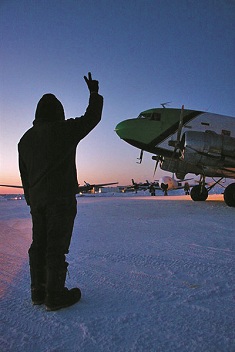 About five years ago a couple of producers looked to break into reality TV with an aviation version of Ice Road Truckers. They met with Buffalo Airways, and decided to shoot a five-minute-long pilot. The program, Ice Pilots, is shooting its fifth season now.
About five years ago a couple of producers looked to break into reality TV with an aviation version of Ice Road Truckers. They met with Buffalo Airways, and decided to shoot a five-minute-long pilot. The program, Ice Pilots, is shooting its fifth season now.
Buffalo Airways operates daily, hauling freight and people all over the Northwest Territories and Alaska. Its fleet of 60 airplanes now includes three Lockheed Electras and the last scheduled DC–3 passenger service on the planet. “The TV show looks kind of dangerous—it’s all very real,” says Chief Pilot Justin Simle. “Everything that happens, happened. It’s 5,000 hours of footage shot over nine months.”
Simle started with Buffalo 12 years ago as a ramp worker, then co-pilot on the DC–3, then the DC–4, then C–46. As co-pilot of a Canadair 215, he got into aerial firefighting. Then he made captain on the Beech Baron, then the DC–3, and DC–4. And now he’s chief pilot, in charge of flight operations.
“The most exciting footage ends up in 13 episodes,” he explains. “Most of it is the mundane, actual stuff we do. For the most part it’s pointing old airplanes into short runways. Part of it is hair-raising; you’ve got to have pretty good hands and feet. It’s not a Boeing 777. The gauges are steam driven, there’s GPS for reference, and we really don’t need much more than that. Like I said, it’s exciting for other people, but not for us. If it were that stressful we’d find another line of work.”— Phil Scott
Test Pilot by Barry Schiff
- From reader John Schmidt: What was so unique about the bomb dropped on North Vietnam to commemorate the 6 millionth pound of ordnance dropped on that country by the United States during the Vietnam War?
- When the surface wind blows across a runway at a _____-degree angle, the crosswind component during takeoff or landing is half the reported wind speed.
- From reader Paul Reinman: There are four forces—one of them is P-factor—that contribute to the left-turning tendency of a single-engine, propeller-driven airplane. What force tends to yaw a tricycle-gear airplane to the right when raising the nose for liftoff?
- Balloon fenders were used on
- airplanes.
- balloons.
- dirigibles.
- gliders.
- During World War II, a pilot flying low over the coast of New Ireland (an island in Papua New Guinea) spotted a lone Japanese soldier striding across a beach and totally exposed to the approaching Corsair. The pilot was touched by the soldier’s bearing, stride, and dignity, his refusal to run for cover. Instead of firing his guns, he pulled skyward and sought another target. Who was this famous pilot?
- True or False? A pilot may drop a bowling ball from his aircraft while in flight.
- A pilot planning a flight at an FBO was overheard saying apologetically, “I’m postponing my flight because of poor visibility. I’m only a student.” What experienced pilot replied with, “That’s OK, son. So am I”?
- Why is that sultry time of year between early July and early September referred to as the “dog days of summer”?
See answers below >>
New home for early ‘Air Force One’?
By Jim Moore
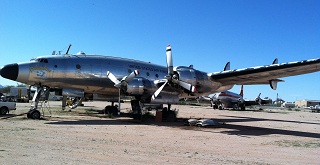 A former presidential aircraft, possibly the first to fly under the call sign Air Force One, remains in private hands, though the owners are eager to find a more appropriate home for the old Lockheed Constellation.
A former presidential aircraft, possibly the first to fly under the call sign Air Force One, remains in private hands, though the owners are eager to find a more appropriate home for the old Lockheed Constellation.
Dubbed Columbine II by President Dwight Eisenhower, the Constellation—designated a C–121 by the U.S. Air Force—served as Eisenhower’s personal air transport beginning in 1952, when it flew Eisenhower, then president-elect, on a top-secret mission to Korea. In 1954, Columbine II was replaced as the primary presidential aircraft by Columbine III, a Super Constellation, but remained in service as a backup Air Force One until 1959. Today, it awaits restoration in the Arizona desert, following a brush with the scrapyard decades ago.
Retired from service in 1968, the military put Columbine II up for sale, along with four other Constellations that had been used for VIP transportation.
The quintet caught the eye of Mel Christler in 1970. Christler operated Cristler Flying Service, and was building up a fleet of aerial sprayers to win a government contract to eradicate fire ants. Columbine II had been fitted with landing gear designed for the larger Super Constellation, and was used for spare parts to keep the other four flying.
“It appears that the military let loose of it by mistake,” Christler’s grandson, Tim Crowley, said.
The constellations, according to Christler, were not well-suited to distributing the dry fire ant bait, but came into their own during Canada’s battle against the Spruce Budworm, and in U.S. efforts to control grasshoppers.
In 1980, a call from the Smithsonian National Air and Space Museum alerted Christler that his “spares” Constellation was a former presidential aircraft. In the years to come, Christler would team up with his son, Lockie, and other family members to restore Columbine II. Harry Oliver joined the effort in 1989, and remains a co-owner today. By 1990, the aircraft had been restored to flying condition, standard Air Force livery removed in favor of the presidential paint scheme. Columbine II was flown to various events commemorating Eisenhower’s one-hundreth birthday in 1990, and joined a few airshows in 1991. Oliver and Lockie Christler have tried for years to find a buyer, or a museum willing to trade for the aircraft, but it stirred little interest until recently. Brett Crowley, Lockie’s nephew and the late Mel’s grandson, said active discussions are under way with the Air Mobility Command Museum in Dover, Delaware, that may give Columbine II a new home.
The owners hope to once again restore the aircraft, now stored on an airfield in Tuscon, Arizona, to flying condition, and secure a ferry permit to bring it east.
“She needs to fly at least one more time,” Brett said. But Tim said making the aircraft airworthy may be a challenge: It basically needs an annual, he said—one that could cost about $200,000.
Columbine III, which replaced Columbine II in 1954 as the primary presidential aircraft, is today in the collection of the National Museum of the U.S. Air Force in Dayton, Ohio. It was the last propeller-driven presidential aircraft, giving way to the Boeing 707 under President John F. Kennedy. The Air Force began using the Air Force One call sign in the 1950s to avoid confusion with airlines operating with similar call signs. It is not clear which of the two Columbines were first flown under the now-famous call sign that indicates an aircraft has the president on board. It is well-established, however, that Eisenhower used Columbine II on several occasions, a fact that Mel impressed on his grandson in 1989, when Brett visited the aircraft during a vacation from military school.
“He showed me a mirror,” Brett said, recalling a moment that left a lasting impression. “Can you see Eisenhower there?”
Email [email protected].
Test Pilot Answers
- It was a toilet filled with explosive material and modified with a rack, fins, and a nose fuse. It was dropped by Cmdr. Clarence Stoddard from the right wing of his Douglas A–1H Skyraider, Paper Tiger, during October 1965.
- Thirty. In trigonometry, the sine of 30 degrees is 0.5.
- Gyroscopic precession tries to yaw a tricycle-gear airplane to the right during rotation just as it causes a taildragger to yaw left as its tail is raised during the takeoff roll.
- (a) During World War II, balloon fenders were guard rods that extended from the wing tips to the nose of an airplane to protect it from being damaged by the cables of barrage balloons.
- Charles Lindbergh wrote numerous times about this experience.
- True. Federal Aviation Regulation 91.15 allows a pilot to drop any object as long as “reasonable precautions are taken to avoid injury or damage to people and property.”
- It could be any pilot with the wisdom and humility to appreciate that all of us are aviation students, regardless of our experience and ratings.
- This is when Sirius, the dog star (and the brightest star in the night sky), rises and sets with the sun.
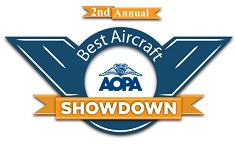 Best aircraft showdown
Best aircraft showdown
Join the madness of March and choose your favorite aircraft in AOPA’s second annual “Best Aircraft Showdown.” Help choose the starting 64 aircraft and winners from each bracket will advance until we have a winner. Last year’s favorite—the P-51 Mustang—has been retired.
